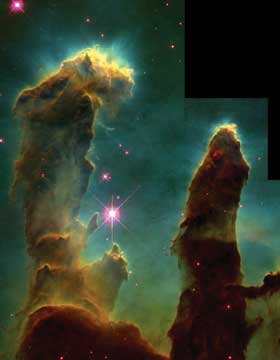|
DOWN TO EARTH WITH...: News about people from AGI and its 44 member societies
Archive of past profiles stories by date
Robert Nemiroff and Jerry Bonnell
 |
The Hubble Space Telescope's Pillars of Creation image of the Eagle Nebula 7,000 light-years away was first taken in 1995, and later re-imaged with NASA's Chandra X-ray Observatory on Feb. 15, 2007. The image was featured on Astronomy Picture of the Day on Feb. 18, 2007. Photograph is by Ken Kostel. |
In 1995, astrophysicists Bob Nemiroff and Jerry Bonnell launched a Web site to share some of their favorite starry pictures with the world. They called the site "Astronomy Picture of the Day" (antwrp.gsfc.nasa.gov/apod/astropix.html), and kept the format simple: one pretty picture per day, and a concise explanation of what exactly the viewer is seeing.
Over the past 12 years, Bonnell, of NASA's Goddard Space Flight Center in Greenbelt, Md., and Nemiroff, now at Michigan Technical University, have maintained the simple and direct format of the site's early days. But with mirror sites in 18 countries, a message board to discuss the images and two books featuring the best of the best, the site has become widely popular, and its pictures captivate not only astronomers, but also desk-bound professionals who like to keep a galaxy or distant sun tucked behind their spreadsheets.
Bonnell (JB) and Nemiroff (RN) sat down with Geotimes’ Carolyn Gramling to talk about finding images, detecting fakes and 2001: A Space Odyssey.
Q: How did you decide to create the Web site?
JB: It grew out of conversations that Bob and I would have over lunch, over what the World Wide Web really was, and how we could make a contribution. Bob and I were officemates at Goddard in those days.
RB: We bandied about several ideas; one was answering questions. But we thought there were a lot of images [Hubble] that were being sent around by e-mail, that were not explained, and we wanted to explain them. There was some debate about whether we'd run out of pictures or not. But we reject images 10 to one now. The bigger danger was that the site would get very boring — for example, during [NASA's] Ranger series of missions to the moon, they took hundreds of thousands of pictures, and [we worried that] it'd be like "this is Crater 8642 — it's somewhat greyer than yesterday."
Q: So who sends in all the images?
RN: People who are amateur astrophotographers, who are in the right place at the right time, also publicity officers for major telescopes. We're on lots of e-mail lists too. We get alerts when Hubble has a new image.
Q: Is it still just the two of you choosing which images to put up? How long does it take to sift through them all?
RN: Most people think there's a building somewhere full of staff but it's just us. But it only takes a few hours a week to go through them.
Q: Has anyone sent in any fake or spoof pictures?
JB: Very few. We do get images in which the people sending them don't know what they are. There was a popular one years ago that claimed to be a picture of Earth at night, taken from the space shuttle or something like that. In fact it was a mosaic of many, many images taken by a project which has a constellation of satellites.
Q: You knew it wasn't real right away?
JB: Yes. How can you take a picture of the entire Earth at night? And there were no clouds. There are things like that that seem to have a really long life on the Internet, and we get those sometimes.
RN: There was a picture of the sun and moon at the North Pole. In actuality, the angular size of the sun and moon are the same, but in the picture they weren't. I kept getting sent that picture, so I decided to track down who made it, and eventually located the original artist, who claimed it. We did post it, but with the proper explanation. We like doing that because it's one of the reasons the Web site was created: We want things to be properly explained.
Q: Among all the pictures you get, do you have any favorites? Or do they start to run together over time?
JB: I like a lot of the Hubble Space Telescope Views. I'm always a sucker for a big bright spiral galaxy.
RN: I like the pictures that when you look you just think, wow, what is that? One of the most famous is the Pillars of Creation. We still get pretty startled — and the images have gotten better over the years.
Q: Are you planning any changes to the site?
JB: I hate to mess with it too much. I think one of the reasons it's done so well and we can still handle it is that it's very simple and straightforward.
RN: We've had a similar format since 1995 — name another Web site that's done that! In a universe of change, our format is refreshingly constant.
Q: On to the important stuff. Favorite space movies of all time?
RN: The classic: 2001. I go for space movies generally, although they can get kind of hokey.
JB: I enjoyed a series my 18-year-old discovered for me, called Firefly. And I like the classics, too. 2001 was the first movie I saw over and over again. I must have seen it upwards of 12 times when I was a kid.
Links:
Astronomy Picture of the Day

 Subscribe
Subscribe


